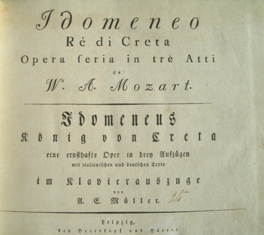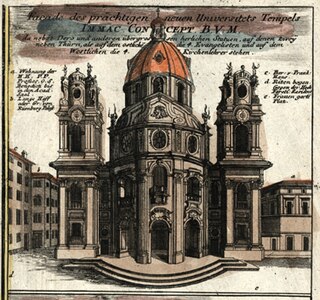Related Research Articles

Idomeneo, re di Creta ossia Ilia e Idamante is an Italian language opera seria by Wolfgang Amadeus Mozart. The libretto was adapted by Giambattista Varesco from a French text by Antoine Danchet, based on a 1705 play by Crébillion père, which had been set to music by André Campra as Idoménée in 1712. Mozart and Varesco were commissioned in 1780 by Karl Theodor, Elector of Bavaria for a court carnival. He probably chose the subject, though it may have been Mozart. The work premiered on 29 January 1781 at the Cuvilliés Theatre in Munich, Germany. It is now considered one of the greatest operas of all time.

The Requiem in D minor, K. 626, is a requiem mass by Wolfgang Amadeus Mozart (1756–1791). Mozart composed part of the Requiem in Vienna in late 1791, but it was unfinished at his death on 5 December the same year. A completed version dated 1792 by Franz Xaver Süssmayr was delivered to Count Franz von Walsegg, who commissioned the piece for a requiem service on 14 February 1792 to commemorate the first anniversary of the death of his wife Anna at the age of 20 on 14 February 1791.

The Piano Concerto No. 20 in D minor, K. 466, was composed by Wolfgang Amadeus Mozart in 1785. The first performance took place at the Mehlgrube Casino in Vienna on 11 February 1785, with the composer as the soloist.

Great Mass in C minor, K. 427/417a, is the common name of the musical setting of the mass by Wolfgang Amadeus Mozart, which is considered one of his greatest works. He composed it in Vienna in 1782 and 1783, after his marriage, when he moved to Vienna from Salzburg. The large-scale work, a missa solemnis, is scored for two soprano soloists, a tenor and a bass, double chorus and large orchestra. It remained unfinished, missing large portions of the Credo and the complete Agnus Dei.

The Krönungsmesse, composed in 1779, is one of the most popular of Wolfgang Amadeus Mozart's 17 extant settings of the Ordinary of the Mass. It can be classified as either a Missa brevis or a Missa solemnis because although it includes all the sections of the Ordinary, it is relatively short.

Wolfgang Amadeus Mozart's Horn Concerto No. 3 in E-flat major, K. 447, was completed between 1784 and 1787, during the Vienna Period.
The Maurerische Trauermusik in C minor, K. 477, is an orchestral work composed by Wolfgang Amadeus Mozart in 1785 in his capacity as a member of the Freemasons.
Benjamin-Gunnar Cohrs is a German conductor, scholar, and publicist on music.
Ave verum corpus, , is a motet in D major composed by Wolfgang Amadeus Mozart in 1791. It is a setting of the Latin hymn Ave verum corpus. Mozart wrote it for Anton Stoll, a friend who was the church musician of St. Stephan in Baden bei Wien. The motet was composed for the feast of Corpus Christi; the autograph is dated 17 June 1791. It is scored for SATB choir, string instruments and organ.
The Missa brevis in G major, K. 140, K3 Anh. 235d, K6 Anh. C 1.12, was probably composed by Wolfgang Amadeus Mozart shortly after returning to Salzburg, in March 1773, from his third trip to Italy.
The six string quartets, K. 168–173, were composed by Wolfgang Amadeus Mozart in late 1773 in Vienna. These are popularly known as the Viennese Quartets. Mozart may have hoped to have them published at the time, but they were only published posthumously by Johann André in 1801 as Mozart's Op. 94.
The Sparrow Mass is a mass in C major K. 220/196b, Mass No. 9, Missa brevis No. 5, composed by Wolfgang Amadeus Mozart in 1775 or 1776 in Salzburg. The mass is sometimes termed a missa brevis et solemnis, because it is short in a simple structure as a missa brevis, but festively scored like a missa solemnis with brass and timpani in addition to four soloists, strings and organ. It was possibly first performed on 7 April 1776 in a mass for Easter at the Salzburg Cathedral. The nickname is derived from violin figures in the Hosanna which resemble bird chirping.

The Missa solemnis in C major by Wolfgang Amadeus Mozart, K. 337, was written in 1780 for Salzburg. It was Mozart's last complete mass. The mass is scored for soloists, choir, 2 oboes, 2 bassoons, 2 trumpets, 3 trombones, strings and organ, the latter supplying figured bass for most of the duration.

The Symphony in A minor "Odense", K. Anh. 220/16a, was formerly attributed to Wolfgang Amadeus Mozart. It is one of only three symphonies possibly by Mozart to be in a minor key.

The Missa brevis in D major, K. 194/186h, is a mass composed by Wolfgang Amadeus Mozart and completed on 8 August 1774. It is scored for SATB soloists, SATB choir, violin I and II, 3 trombones colla parte, and basso continuo.

The Missa brevis in D minor, K. 65/61a, is a mass composed by Wolfgang Amadeus Mozart and completed on 14 January 1769. It is scored for SATB soloists and choir, violin I and II, 3 trombones colla parte, and basso continuo.
This article lists some of the modern completions of the Requiem by Wolfgang Amadeus Mozart.

Wolfgang Amadeus Mozart composed four litanies in his service as a church musician for the Salzburg Cathedral, two of which are settings of the Litaniae Lauretanae, the Litany of the Blessed Virgin Mary. The other two are settings of the Litaniae de venerabili altaris sacramento, venerating the Eucharist. Mozart composed the works for four soloists, choir, instruments, and continuo. The litanies appeared in Bärenreiter's Neue Mozart-Ausgabe (NMA) in 1969.
References
- 1 2 Robins, Brian. "Kyrie for chorus & orchestra in D minor, K. 341 (K. 368a)". AllMusic. Retrieved November 29, 2016.
- ↑ Cohrs, Benjamin-Gunnar (2013). "Mozart, Requiem KV 626" (PDF). Retrieved November 29, 2016.
- ↑ Zaslaw, Neal (2006). "Program Notes: Kyrie in D Minor, K. 341 (368a)" (PDF). Frank Henderson's Page on Liturgy and Medieval Women. Saint Paul Chamber Orchestra. Retrieved November 29, 2016.